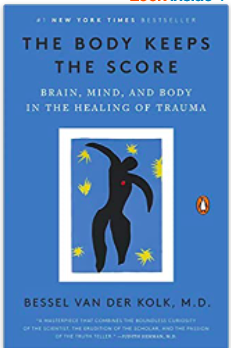The post Sexual Abuse & Emotions and Feelings on #sexabusechat appeared first on PTSD Parent.
]]>Sexual Abuse & Emotions and Feelings
In the process of going through trauma (especially sexual abuse), our survival mechanism is to disconnect the body and the brain. The first things to be shut down are emotions and feelings – sensing, allowing, connecting, identifying, processing, and communicating.
Our emotions are first felt in our bodies, and the survival instinct to disconnect the body from the brain keeps us from processing, releasing, and making meaning from these emotions and feelings. This energy lives in our cells, muscles, and tissues, making our bodies more and more uncomfortable. (For a lot more about this, check out The Body Keeps the Score.)
One of my passions in this trauma and grief recovery work is encouraging and teaching people how to feel safe and secure while reconnecting their bodies and brains. Processing emotions and feelings can feel threatening. It takes gentleness, compassion, and curiosity to begin to open the door to this kind of reconnection.
What is #sexabusechat?
The community #sexabusechat draws survivors of childhood sexual abuse and sexual assault. This chat takes place primarily on Twitter, with weekly spotlights on advocates for recovery from this type of trauma. There is a guest speaker each week, and listeners can join in with a link – no need to be active on Twitter to listen in and ask questions.
My episode was about emotions and feelings and how to deal with them as a survivor of childhood sexual abuse and all of the trauma that goes along with that. Some of the topics covered include why we as sexual abuse survivors have trouble regulating emotions, how to deal with emotional responses and PTSD triggers, and a helpful acronym for regulating emotions. Take a listen below ~
Additional Resources From This Episode
There was a lot to cover, and the questions and collaboration were wonderful. Some of the additional mentions include these articles, which explore the link between sexual abuse and addiction.
Understanding the Link Between Sexual Abuse & Addiction | Tranquil Shores
“A study in the Journal of Traumatic Stress indicated 90 percent of women who became dependent on alcohol were violently abused by a parent or were sexually traumatized as a child.
Additionally, youth with a history of child sexual abuse were 2-3x times more likely to have drug dependence than peers who were not traumatized.
Some studies indicate that drug abuse is more common than alcohol use in adolescents who have been sexually traumatized.”
Sexual Trauma and Addiction: Understanding Child Sexual Abuse and Drug Use – Drug Rehab Options
Speaking of addiction, Seeking Safety Coming Soon
One of my goals is to work with people with PTSD using the Seeking Safety curriculum. I’ve been through a couple of groups using Seeking Safety and really liked what it offered, as well as the group dynamic. This group is for those who have experienced trauma, or have PTSD, or are in substance use recovery, or any or all of the above.
If you’re interested in a future Seeking Safety group, sign up below:
Try Trauma Recovery & Grief Recovery Coaching
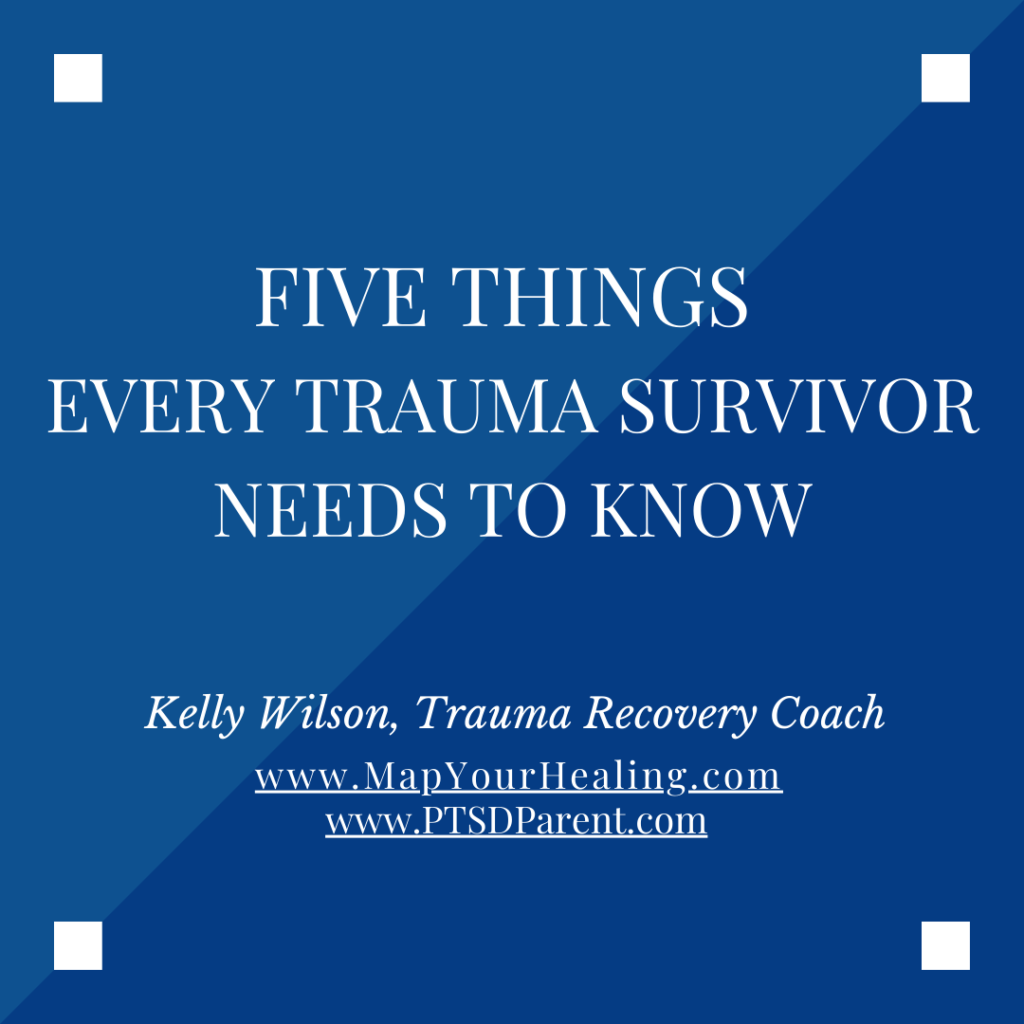
Sign up here to get a free copy of Five Things Every Trauma Survivor Needs to Know
Find out more about Trauma and Grief Recovery Coaching
I offer one-on-one sessions, groups, PTSD Remediation, and classes. Appointments are offered in-person and online.
Try Trauma Recovery and Grief Recovery Coaching for Free! Book an appointment or schedule your FREE 30-minute discovery call to learn more!
The post Sexual Abuse & Emotions and Feelings on #sexabusechat appeared first on PTSD Parent.
]]>The post Making Mother’s Day a Peaceful Holiday appeared first on PTSD Parent.
]]>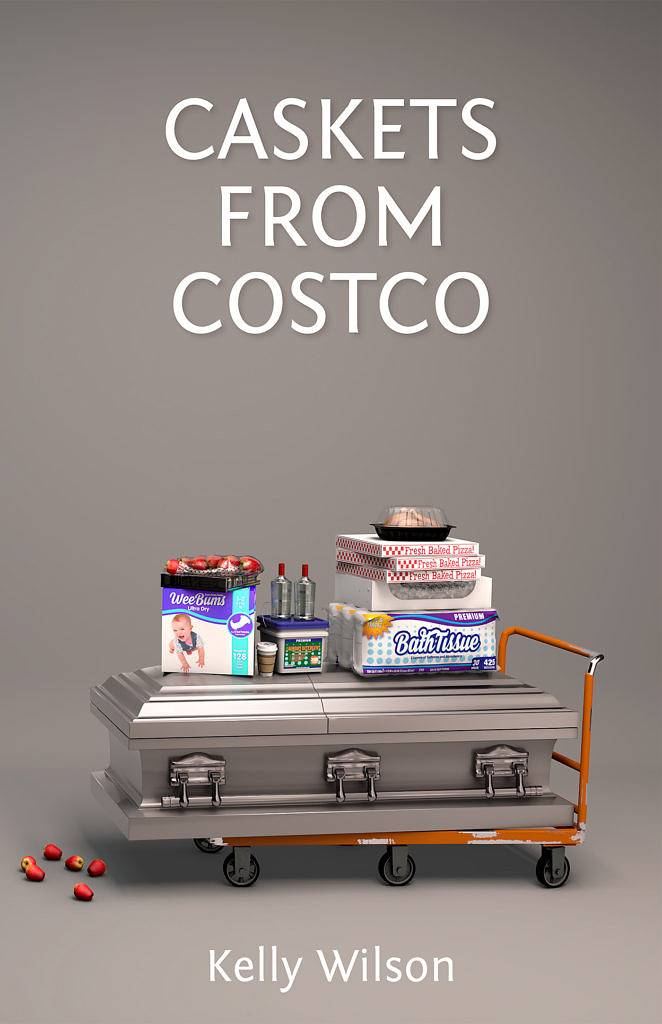
I am estranged from my mother (and other family members) due to past family trauma.
I am a survivor of childhood sexual abuse by my father. When I was 16, I disclosed this to my mother through a series of truly unfortunate events (details can be found in Caskets From Costco). We pursued legal action, and nothing happened – meaning, he was not convicted or trialed or jailed or anything like that.
A few months later, through another series of unfortunate events, he showed up at our home. My mother took him back, over my protests. A few weeks after that, he walked away, got a divorce from my mother, and married somebody else. So, yeah, Mother’s Day can be tough.
There are many reasons that this holiday can cause discomfort and pain. Here are some tips to help manage PTSD around Mother’s Day.
Make a Mother’s Day Plan
One of the ways to manage ourselves and PTSD triggers during Mother’s Day is to make a self-care plan. Here’s an example that might help.
Acknowledge what is difficult about the day. If you wake up and you can tell it’s a tough day, acknowledge that reality. Simple acknowledgement goes a long way toward peace.
Decide what you will not do. Many times, deciding what you will not do is far easier than figuring out what you like or want to do. For instance, I will NOT be doing the dishes that day.
Schedule everything, including rest, for that day. Figure out what you’d like to eat, do, and even wear (pajamas, anyone?)
Ask for help. Manage expectations, including your own. If you want or need something, ask a safe person in your life to help you out.
Focus on what you love. I don’t mean toxic positivity, where you pretend that you’re happy and “everything’s fine.”. I mean finding one tiny (or big) thing during a moment that you love. Maybe it’s the taste of chocolate on your tongue or the feel of your favorite sweater.
Making a plan is one of the proactive ways to manage triggers on a day of emotional landmines. This can help you stay present, which can be really difficult to do with PTSD.
Seek Peace with Grounding Techniques
One of the toughest things to do when having a trigger is becoming aware of it either right before it happens or when it’s happening. Awareness of triggers can help build in pauses – maybe the tiniest of pauses – where we are reminded to ground ourselves.
Here is a video I made of a breathing exercise that I like to do when I feel agitated.
Other easy grounding exercises include the 5-4-3-2-1 and the what I call “the color picker.” In the 5-4-3-2-1, count 5 things you see, 4 things you hear, 3 things you can touch, 2 things you can smell, and one thing you can taste. With “the color picker,” look around and count how many things around you are red (or another color, if you prefer).
In a trigger emergency, I’ll share a secret with you that one of my therapists taught me. If you are agitated and feeling out of control, stand up and spin or twirl 10 times in a row. This taps into the where the vagus nerve hits the inner ear, and gives us a reset.
Be Gentle With Yourself
No matter what, let’s be gentle with ourselves.
We deserve peace, especially on Mother’s Day.
About Trauma Recovery & Grief Recovery Coaching
Kelly Wilson of PTSD Parent is a Trauma Recovery Coach and Grief Recovery Specialist. In 2020, she worked with a therapist and completed PTSD Remediation, a technique that uses the vagus nerve to eradicate PTSD triggers.
Sign up here to get a free copy of Five Things Every Trauma Survivor Needs to Know
Find out more about Trauma and Grief Recovery Coaching
I offer one-on-one sessions, groups, PTSD Remediation, and classes. Appointments are offered in-person and online.
Try Trauma Recovery and Grief Recovery Coaching for Free! Book an appointment or schedule your FREE 30-minute discovery call to learn more!
The post Making Mother’s Day a Peaceful Holiday appeared first on PTSD Parent.
]]>The post PTSD and Trauma Recovery Coaching appeared first on PTSD Parent.
]]>So What is a Trauma Recovery Coach?
I get this question a lot, and with good reason. Becoming a Trauma Recovery Coach is on the cutting edge of mental health, which means that this is an innovative way to provide mental health care. Also, it means that nobody knows what I do, exactly.
In short, I help trauma survivors build a life they have always deserved and wanted. But how?
Here are several questions that help explain my role as a Trauma Recovery Coach. Is there a question I didn’t answer? Please add it in the comments!
Is This Therapy?
Therapy is a good place to start when explaining what a Trauma Recovery Coach does with clients. Therapists and Trauma Recovery Coaches meet with clients and work on specific issues over time. Therapists and Trauma Recovery Coaches know a ton about trauma, mental illnesses, grief and loss, and more. We all care about our clients reaching healing milestones and creating the happiness and life they have always deserved and wanted.
So what are the differences? Therapists do three things that Trauma Recovery Coaches do not do: diagnose mental illness, prescribe or suggest different medications, and create specific treatment plans. I know a lot about mental illnesses but I do not diagnose. This is out of my scope of competence. It takes several years to learn how to diagnose, and sometimes professionals still get it wrong before they get it right. I also do not suggest or prescribe medication, which is the job of a medical doctor or psychiatrist.
Last, I don’t create treatment plans. Individuals come to me and we work together on the issues and challenges that are present. We live in the now, and we lead from behind, providing voice and choice for our clients.
Is This Just Life Coaching?
I am confident about providing life coaching if that’s what clients are looking for. One aspect of life coaching in that I support my clients and what they want to do in their lives. However, I provide so much more as a Trauma Recovery Coach.
The primary difference is that Trauma Recovery Coaches are trauma-informed. We are trained to understand and address the unique challenges and mindsets that trauma survivors experience. As a trauma survivor myself, I have a unique perspective and set of skills to address trauma-related issues as we meet over time.
Do Trauma Recovery Coaches Work with PTSD?
Absolutely! Trauma Recovery Coaches have all kinds of specialties. My specific specialty is PTSD Remediation. Diagnosed with Post Traumatic Stress Disorder in 2006, I lived with PTSD for most of my life, until PTSD Remediation eradicated the symptoms. I continue to learn all I can about PTSD and the emotional, mental, and physiological fallout from childhood sexual abuse. That is my background and I have passion and purpose to help others with these issues.
Are Trauma Recovery Coaches Certified?
Trauma Recovery Coaches need to be certified. As of now (fall 2021), I am waiting on certification from the International Association of Trauma Recovery Coaching. I just need my portfolio to be approved! But I have had the necessary education for certification. Plus I will continue to studying with them – and other notable organizations – to gain more knowledge, wisdom, and experience.
What if I’m Not a Trauma Survivor?
Everyone struggles with different things. I welcome people of all kinds, trauma or not. We are in this together.
How Do I Find Out More About Trauma Recovery Coaching?
I offer a free 30-minute discovery call so that you can find out what you need to know, if we have a connection, and if you want to move forward on this journey of hope and healing. Another way is to sign up here to keep in touch and get to know me a little better!
Do you have more questions? Put them in the comments for more answers!
The post PTSD and Trauma Recovery Coaching appeared first on PTSD Parent.
]]>The post PTSD and the July 4th Holiday appeared first on PTSD Parent.
]]>
The good news is that there are ways we can protect ourselves during the July 4th holiday from environmental triggers that can eat up an hour or a day or more of our lives. Here are five ways to lessen the impact of the noisy July 4th celebrations. Enjoy the acronym, where if you put the first letters of each one together, it makes the word SPARK!
I know, I’m sorry, I can’t help it. Hopefully, though, one or more of these suggestions will resonate and be useful during the July 4th weekend.
Stay Home…or Don’t
Staying home is one of the safest ways to guard against PTSD environmental triggers during this holiday. But maybe you’re not into isolating or staying home.
The important point is that you have the choice and you have your own voice. You get to decide how, where, and when you will – or will not – celebrate our nation’s birthday over the weekend. You get to decide if you will stay for the fireworks or if you will stay home. Either way, you remain in control, and that in itself will help cut down triggers.
Plan Ahead
Planning ahead also helps to avoid unexpected triggers, even if your plan is to not have a plan. If structure helps, create a schedule of the activities for the weekend and especially for July 4th. Maybe there’s a fun parade in town, or maybe the crowds would be too much. Perhaps some time relaxing by a nearby river or lake would be welcome, or inviting people over for a barbecue. Maybe you would rather take advantage of the holiday with some typical weekend activities and a nap. Making a plan will help soothe your nervous system and make it easier to cope.
Ask for Help
If you’re spending time with others during the July 4th holiday, setting some preventative boundaries can help avoid potential triggers. Decide what you want to do on that day. For example, do you want to go to any barbecues? The town’s parade? The fireworks?
If you do decide to participate in any of these activities, consider that you don’t have to stay the whole time. You always have a choice. And you don’t have to do any of this alone. Go to these events with trusted friends and family members who are aware of your triggers and what you might need. When you feel a trigger coming on, you’ll be able to ask for what you need, including space and time for quiet or to simply get going.
Rest Beforehand
Let’s face it, these events and the possible triggers are exhausting. They are also fun and exciting, but they require some planning on our end to make things as peaceful as possible during this holiday. Be ready to deal with triggers by resting up beforehand so that you can make the most of the time out with friends and family at these fun activities. And do not forget to rest afterward to be able to enjoy the demands of everyday life.
Know Your Self-Soothing Skills
Escaping for a couple of moments to self-soothe is an important way to be able to have fun and practice self-care. This could look like escaping the heat by finding a piece of cool shade and spending some time alone. Breathing techniques, grounding exercises, and meditation are also helpful for self-soothing anywhere and at any time. I’ve been known to do a short meditation in a friend’s bathroom so that I practice self-soothing and avoid potential triggers.
There are many ways to help ensure that this fourth of July weekend will be a celebration worth remembering. And fortunately, the choices are yours to make regarding how you enjoy it!
The post PTSD and the July 4th Holiday appeared first on PTSD Parent.
]]>The post How to Not Have a PTSD Crap Attack During Vacation appeared first on PTSD Parent.
]]>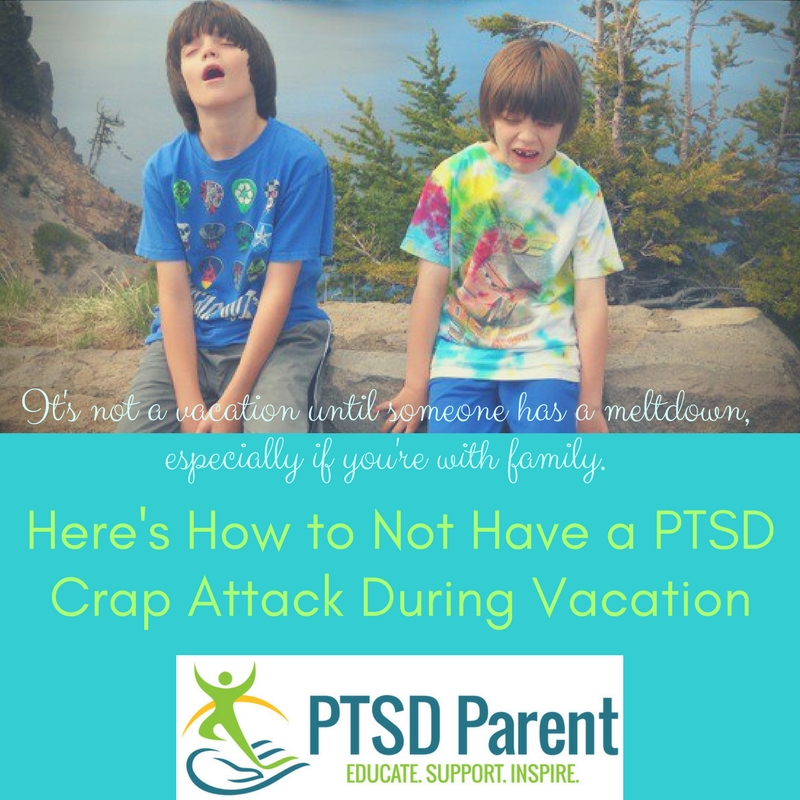
It’s not a vacation until someone has a meltdown, especially if you’re with family. This can be even more of a certainty for those of us with Post Traumatic Stress Disorder.
Lately, I like to refer to my PTSD trigger events as “crap attacks.” First, it makes me laugh. Second, I got it from the TV show Bob’s Burgers, which I binged on during the last year and it is now one of my favorites. I believe the line was spoken by Tina – a teenager – who said, “Geez, Mom and Dad, don’t have a crap attack.” Since I have teenagers, I busted a gut so hard my kids now randomly yell out, “Crap attack!”
My PTSD “crap attacks” can show up even on the most relaxing or fun vacation. Here are some ways that we can take care of ourselves to avoid PTSD triggers during this down time.
[Tweet “Here are some ways that we can take care of ourselves to avoid PTSD triggers during vacations.”]
Manage Expectations of the Vacation
Some vacations do not feel like my idea of a “vacation.” I move at a slower pace than most people. While I enjoy and appreciate adventure, I’m also up for hours in the sun by the pool, dozing and reading. Others in my family – with whom I love to spend time – do not appreciate all of this down time; they like to stay on the move.
For example, when we go to Disneyland with the high school band, I know that I’m not going to have hours by the pool. I know that it will be an exciting and busy series of days, which I will enjoy, but can also make me cranky. I know that the crowds and music and heat will get to me after awhile, and I’ll probably hide somewhere – even in the nearest bathroom. Not my ideal, but managing my expectations for the vacation ahead can help me keep my emotions in check.
I don’t need to plan out every day of my vacations, but I do like to be prepared before I get there. I check out the weather, the hotel, and read up on any of the places we plan to visit. This helps me manage my expectations for the days ahead.
Bring Comforting Stuff
 Hotels can feel sterile to me, even when they’re nice. I don’t know about you, but I can never have enough blankets and pillows. I always pack a thin but comfy and familiar blanket with me, along with my favorite pjs, snacks, books (on my Kindle to make packing easier), and even a couple of movies or shows I can stream.
Hotels can feel sterile to me, even when they’re nice. I don’t know about you, but I can never have enough blankets and pillows. I always pack a thin but comfy and familiar blanket with me, along with my favorite pjs, snacks, books (on my Kindle to make packing easier), and even a couple of movies or shows I can stream.
Sometimes new surroundings can be overwhelming, and coming back to our familiar and favorite things can be very comforting. When I feel extra tired and my defenses are down, I can take a time out with a good book or one of my favorite shows, do some meditation, eat a filling snack, and be ready to head out again.
Do the Boring Stuff
It’s really tempting to have the “Hey, It’s Vacation!” mindset about everything, this may not be the best choice. At least, it’s not sustainable for me. Sure, I can eat a bacon burger and drink a couple of beers and miss my meds for a day and stay up until 2 a.m., but I will pay the consequences.
That’s the hard truth that I need to remember. I make choices and there are consequences. When I don’t do the typical self-care routines that keep me sane, my defenses can fail and PTSD crap attacks are more likely to occur.
On vacation, I try to do as many routine things as possible. If I don’t go to bed at the same time I usually do at home, that’s cool, but I need to try and get eight to ten hours of sleep. I eat regularly throughout the day – more often if we’re walking all day long, like at an amusement park. I pack my meds where I can see them, making them easy to find and take each day. While it’s tempting to skip out on this boring stuff, it can help reduce the chances of a PTSD trigger event.
Take a Time Out
 Since I get overwhelmed in my own home, it’s reasonable to expect that I may be overwhelmed at some point while on vacation. Regardless of where I’m vacationing, I plan one evening that I call, “Introvert Night!”
Since I get overwhelmed in my own home, it’s reasonable to expect that I may be overwhelmed at some point while on vacation. Regardless of where I’m vacationing, I plan one evening that I call, “Introvert Night!”
Instead of hanging out with everyone else, I stay in my room and enjoy the quiet. Taking advantage of the clean bathtub, I take a soothing bath. I enjoy room service, splurging a little on dinner. I watch a movie or two and read. If there are other introverts that I’m traveling with, I invite them into my sanctuary…or I don’t. It just depends on what I need.
Vacations offer us a chance to manage our PTSD so that we won’t have any pesky crap attacks while we’re trying to relax. Take some time to plan what you might need so that you can make the most out of your vacation.
The post How to Not Have a PTSD Crap Attack During Vacation appeared first on PTSD Parent.
]]>The post PTSD Anger: In Danger of Never Sleeping Again? appeared first on PTSD Parent.
]]>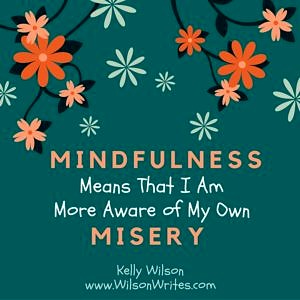 I am so angry, I thought during my guided mindfulness meditation.
I am so angry, I thought during my guided mindfulness meditation.
While it’s not part of every PTSD diagnosis, anger is part of my Post Traumatic Stress Disorder. A common response to trauma of all kinds, this emotional response gives us energy to keep going, and it helps us cope with the stresses of life. The main problem is that we tend to respond to stresses of all kinds at our highest levels of anger.
If you have PTSD, then you know what it’s like to live at a higher level of arousal, from irritation to rage. My muscles are constantly tense, especially in my neck and shoulders, and I operate at a high level of tension – tightly wound, as I like to say – which is my normal state. I am a deep feeler, an intense person; this means that my anger responses are more intense. Many times, I don’t know what to do with all of my emotions.
[Tweet “With PTSD, I don’t know what to do with my emotions, especially anger.”]
Anger is Not Always Violent
While some people with PTSD respond with violence, this isn’t my experience. I go the “freeze” or “flight” response. People like me push down or hide our anger response, and it comes out in self-destructive ways. This could be self-harm, irritability in general and in relationships, trouble sleeping, and addictive behaviors, among others.
My pattern is to notice my emotion, identify it, panic a little because I don’t know what to do next, and shut down. I spend some time denying that I’m angry, because I don’t always know how to deal with it. Maybe if I ignore it, the anger will simply dissipate. Right? No, this never happens.
So How Do I Deal with the Anger?
After going through the denial phase, I decide that I need to somehow resolve this emotion, at least inside myself. I remind myself that I am not a victim, that I am in charge of my mental health. I may go for a really long walk, or write about the events and corresponding emotions, or both. I will eventually decide that I need to face the issue head-on with the other person (if there is one).
I was recently in the middle of dealing with anger when I couldn’t sleep one night. I felt unsettled and agitated and impatient. The situation wasn’t panning out as I had hoped; ultimately this would be okay, because I really only needed to cultivate peace inside of me.
I often practice mindfulness meditation when I’m agitated, especially when I can’t sleep. I sat, listening to the app on my phone, sitting on the floor, legs crossed and hands on my knees. I thought, “I am so angry.” Which seemed entertaining to me during a meditation session, because I imagine I’m supposed to be all Zen and crap, and that is not how any of that works for me.
A picture formed in my mind of this plaque we had hanging on the wall of our house when I was a kid. Along with “Peace” and “Hope” and “Love”, my abusive parents – the two angriest people I knew – had that verse from scripture about not letting the sun go down on your anger. I almost choked on the irony.
Humor Also Helps
As I was meditating on this vision, I immediately thought of a joke. Because if I have PTSD and corresponding anger, and I’m not supposed to go to bed angry, then I guess I will never sleep again.
I laughed, wrote down my joke, and went to bed. I slept like a baby.
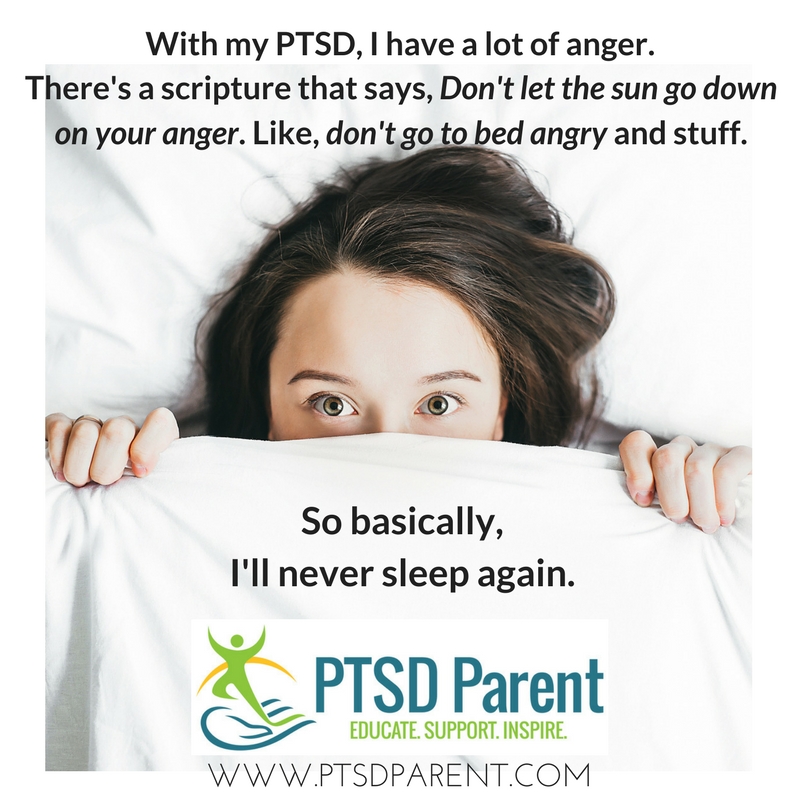
The post PTSD Anger: In Danger of Never Sleeping Again? appeared first on PTSD Parent.
]]>The post How to Show Up for Your Kids Through PTSD Triggers appeared first on PTSD Parent.
]]> My PTSD support group was on the same day as Oldest’s high school open house. I thought going to both might kill me. PTSD triggers were everywhere, like any day as a parent who has post traumatic stress disorder.
My PTSD support group was on the same day as Oldest’s high school open house. I thought going to both might kill me. PTSD triggers were everywhere, like any day as a parent who has post traumatic stress disorder.
Really, I thought that continuing to go to the PTSD support group might kill me. Yes, I’m being dramatic. The PTSD support group is not full of ninjas or anything. However, it reminds me a bit of Fight Club, in that outside of PTSD Fight Club, we don’t talk about PTSD Fight Club, and I feel beat up after each session.
I was only on the second week of a ten week series, and I thought seriously of not going back. Going to the meetings themselves involved a lot of girding of the brain and loins. The baring your soul with other people. The learning more about this bitch of a disorder. The diarrhea right before the support group meeting. The homework (that I completed in the clinic bathroom ten minutes before group started). The being accountable for the new information I was learning. The agitation and restlessness and weepiness.
The sheer fatigue after each meeting. The support group only met for an hour and a half, which left me feeling like I’d been hit by a truck. The idea of attending Oldest’s High School Open House the same day was overwhelming, sending me straight to bed for the afternoon.
Preparing Oldest for High School
It wasn’t just that I was adjusting to the new PTSD support group and learning so many new things about myself that I thought my brain would explode. A big part of my preparation was just realizing that my oldest child who was born only two pounds, 12 ounces almost three months early now stands six feet tall and is in high school.
I have been in denial about this all summer. Guess what? Just because you feel numb about something doesn’t keep it from happening. As I lay in bed that afternoon trying to sleep, I kept thinking over and over again, my oldest is in high school. I can totally do this. I am totally getting hardcore PTSD triggered right now. (What’s a PTSD trigger? Go here for more info)
It would be an understatement to say that high school was traumatic for me. Going to high school in and of itself was actually a safe 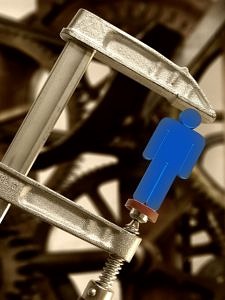 place, but the rest of my life was a shitshow. It was not surprising to me that the idea of being in high school was triggering to me.
place, but the rest of my life was a shitshow. It was not surprising to me that the idea of being in high school was triggering to me.
And even though my entire life basically fell apart while I was in high school and I was completely triggered by *my* kid being a teenager, I had to support him.
I knew I was strong enough to do that, but I wasn’t sure how that would play out. Should I ask someone to come with me for support? Could I plan on leaving the event early? Could I talk myself through the difficulties of the evening? What about meditating? What self care skills could I use?
Showing Up Through PTSD Triggers
There would be many friends of ours at the high school open house, including a few I could corner and ask for help if I needed it. Plus, I could always call a friend on my phone. I decided that I was going to do this, and I had a plan.
After we had arrived at the Open House, Oldest took me on a tour of his typical day. We went to the auditorium and listened to opening remarks by the administration. We visited his classes, which were each five minutes in length. Other parents with their oldest kids entering high school looked as shell shocked as I felt; I found this comforting.
Parents perched on the edge of chairs usually occupied by their kids, looking nervous. A series of teachers explained their syllabi and expectations and best ways to communicate. I kept saying to myself, my oldest is in high school. I can totally do this. I am totally getting hardcore PTSD triggered right now. Until we were almost to the end of the evening.
It was “sixth period” of the Open House during which Oldest’s English Teacher with a ponytail kind of slapped me in the face.
Yes, I’m being dramatic, he didn’t *literally* slap me in the face. He sat facing us, the group of nervous parents, looking us each in the eyes and saying, “It’s okay. If they show up and do the work, they’ll be fine.”
My whole body flinched. I realized in a moment that I had shown up not just once, but twice that day. I was doing the work.
I was going to be okay.
[Tweet ” I had shown up not just once, but twice that day. I was doing the work.”]
Oh Yeah, I Can Do Hard Things
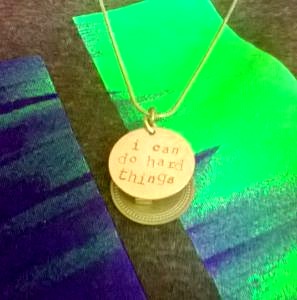
As we headed home, Oldest mentioned that high school, while certainly more fun, was a bit intimidating. How would he keep up with everything? What if he missed something or made a mistake?
“Well, it’s like Mr. English Teacher said,” I reminded him, “if you show up and do the work, you’ll be fine.”
For a little while, I had forgotten. I can do hard things. I’ve done hard things, over and over again. Also, that’s what she said.
This scrappy English teacher reminded me that there is value in putting feet to the floor and being willing to move forward. Triggered or not, I had shown up for my kid.
I had shown up for myself.
Searching for Hope and Inspiration? Check Out Caskets From Costco

A Funny and Poignant Grief Book
For twenty years, I thought that I had been marching through the stages of grief in a straight line. I had been following the formula, crossing each processed grief experience off my list.
Except that I was totally deluded. And I didn’t discover that until Jim, my beloved father-in-law, died. I found myself drying off from my shower the morning after his death, really hoping he couldn’t see me naked. Or, if he could, that he was averting his eyes.
From that moment, my path through grief resembled a roller coaster, spiraling and twisting and turning, circling back around. Echoes of past trauma, including childhood abuse and cheating death, would no longer be ignored. I somehow needed to get from the beginning to the end of this grief adventure, and I don’t have a good sense of direction.
But what is always present during a journey through grief, regardless of the path chosen?
Hope.
Caskets From Costco is a funny grief book that demonstrates the certainty of hope and healing in an uncertain and painful world.
Go Here to Read a Free Excerpt of Caskets From Costco!
The post How to Show Up for Your Kids Through PTSD Triggers appeared first on PTSD Parent.
]]>The post How to Have a Conversation About Sexual Misconduct appeared first on PTSD Parent.
]]>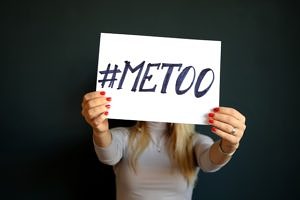
I am writing this on the day of the Alabama Senate Race between Roy Moore and Doug Jones. I have no idea if Moore will be elected to the Senate, even as the claims of sexual misconduct against him continue to gather steam.
I have been nervous all day. Anxious. Stomach in knots and short of breath, especially as the sun goes down. Because soon we will have an answer. Whether this will be another night of broken faith in humanity like the 2016 election, or if there will be a shred of hope in the decency of human beings and the validity of sexual abuse and assault allegations.
For survivors of sexual abuse and assault like me, this is a particularly triggering time. A laundry list of men have been accused of sexual misconduct and have stepped down from their positions of importance and relevance. As a survivor who never got her justice, this is highly satisfying. As an advocate for victims of sexual assault, this is an amazing time.
As a person with trauma-induced Post Traumatic Stress Disorder, I basically feel like throwing up. I’ve got all the feels: anger, rage, worry, sadness, disbelief – the list goes on. And there’s no avoiding the topic, no matter where I go.
I decided that I wanted to manage my triggers during this time but still be able to have conversations with people as the topic comes up. Because no matter what happens specifically with Roy Moore, accusers are continuing to come forward and be attacked by the media and the court of public opinion. Here are a few suggestions to help navigate these conversations about sexual misconduct.
[Tweet “Sexual abuse and assault is a community and cultural problem.”]
What People May Say About Sexual Misconduct
I hear a lot of skepticism and questions about women who are coming forward with accusations of sexual misconduct. Some of them include:
-

Photo by Adi Goldstein on Unsplash “So much time has gone by, it doesn’t even matter anymore.”
- “They just want money.”
- “All these women are just jumping on the bandwagon.”
- “Why didn’t they report it when it happened?”
- “I wouldn’t have put up with it. I would have done x-y-z.”
These are in conjunction with other common statements and questions, like “I wonder what she was wearing,” and “She was probably a heavy drinker,” and “I bet she wanted it.” Which is all victim blaming and in some respects indicates a measure of fear. Sexual abuse and assault is a community and cultural problem.
These kinds of statements and questions may surprise you and – if you have PTSD – send you right down Trigger Alley. If that’s the case, take care of yourself. That is the most important priority.
Keep Sexual Misconduct Personal
 However, if you’re able to share your story of sexual abuse and assault, this is a pretty good time. There is no better spokesperson for the realities of trauma, sexual assault, and PTSD than those of us who have been through it.
However, if you’re able to share your story of sexual abuse and assault, this is a pretty good time. There is no better spokesperson for the realities of trauma, sexual assault, and PTSD than those of us who have been through it.
One of my recent conversations started with the other person saying some of the statements that I outlined above. I was tempted to stay silent, to not rock the boat. Then I reminded myself that I am not that person anymore, and I said, “Well, that’s not the way trauma works.”
“What do you mean?” they said.
“For example, it took me years to tell somebody that my dad sexually abused me,” I said. “For many years, I simply shoved down the memories and feelings and refused to look at them. I was a teenager at the time of my abuse, and wasn’t able to pursue any criminal or civil action. But now? I would totally take him to court, and my sexual abuse happened 30 years ago.”
The fact is, there are many reasons why sexual abuse survivors wait to tell their stories or simply decide never to talk about it. Ironically, this is in large part with how people respond.
Be prepared for awkward silence or a change of subject. The other person may continue to argue. This is a good time to be prepared with facts.
Keep Sexual Misconduct Factual
During a different conversation that I had about sexual misconduct, the other person followed up with versions of, “They’re lying and just want money,” and “I wouldn’t have put up with it.”
In What if Allegations of Sexual Assault are False?, I talk about how there are no advantages to the survivor for disclosing incidents of sexual abuse and assault. Based on evidence, only between two and eight percent of reports of sexual misconduct are false. Perpetrators also groom their victims over time, making it difficult for victims of sexual abuse and assault to get away.
Here are additional helpful facts to memorize:
- More than 90 percent of child sexual abuse victims know their attacker (Center for Family Justice); children are groomed over time to keep the abuse secret.
- 1 in 6 boys and 1 in 4 girls are sexually abused before the age of 18. (NSOPW)
- “Disclosure of sexual abuse is often delayed; children often avoid telling because they are either afraid of a negative reaction from their parents or of being harmed by the abuser. As such, they often delay disclosure until adulthood.” (NSOPW)
- More than 40 percent of children who are abused show no symptoms (NSOPW)
- Only 28 percent of victims report their sexual assault to the police (Bureau of Justice Statistics, Center for Family Justice)
- Between 70 and 90 percent of women who experience sexual misconduct in the workplace do not report it. (NWLC)
- Women do not report sexual misconduct due to fear of losing their jobs, fear of not being believed, belief that nothing will be done and therefore will make the situation worse, and shame and embarrassment. (NWLC)
- Employers are held responsible for sexual harassment in their workplaces. Accusers must prove their cases of sexual misconduct. Then they are eligible to receive monetary compensation. (NWLC)
Sexual misconduct in our mainstream culture is not going to go away anytime soon, and reaches the highest levels of the media, corporations, and government entities. Those of us who have survived sexual abuse and assault are in a unique position to help educate and break through the associated stigma in whatever ways we can.
The post How to Have a Conversation About Sexual Misconduct appeared first on PTSD Parent.
]]>The post How to Be Calm: PTSD and Halloween appeared first on PTSD Parent.
]]> “Hey, Mom, you should come see me at the haunted house,” joked my 15-year-old manchild. He was volunteering at our community’s traditional Halloween fundraiser at the Elks Lodge. (Side note: The haunted house theme is “Asylum,” which is a whole different level of rage for someone like me, working in mental health. We petitioned to get the theme changed, but it fell on deaf ears.)
“Hey, Mom, you should come see me at the haunted house,” joked my 15-year-old manchild. He was volunteering at our community’s traditional Halloween fundraiser at the Elks Lodge. (Side note: The haunted house theme is “Asylum,” which is a whole different level of rage for someone like me, working in mental health. We petitioned to get the theme changed, but it fell on deaf ears.)
“People with Post Traumatic Stress Disorder don’t visit haunted houses,” I said with a smile.
He does, of course, know this, and we joke about it because humor is my primary coping skill. And while I joke around about feeling stressed during Halloween, I’m very serious about how this time of year has an effect on my own PTSD.
[Tweet “Making a plan to stay calm and manage PTSD symptoms is an act of self-care.”]
Tough PTSD Symptoms During Halloween
Halloween can be a tough time for individuals with mental health challenges. While there are parts of this holiday that I enjoy – the decorating for the season, spending time with friends and family, candy – there’s stuff that is just plain disturbing.
While Halloween can be an innocent time of costumes and a wide variety of free candy, there’s a celebration of the darkness associated with October 31st. The blood and gore and jumpscares and hauntings and demons and scary movies. All of these can set off our PTSD symptoms, some of which include:
- Hypervigilance – Feeling like you have to be constantly “on guard” is exhausting. The constant adrenaline and stress hormones are harmful after long periods of time, and it can be really difficult to come down from the Flight-Fight-Freeze response. People at the door triggers my anxiety, especially as my dog starts barking and won’t stop.
- The Startle Reflex – I have the startle reflex when someone comes around a corner on a regular day, so forget people dressing up in scary costumes and losing all sense of personal space. Jumpscares are the worst on a good day.
- Sensitivity to Sound – I am highly sensitive to noise, and my threshold for tuning it out is getting lower as I get older. I’m also noticing that my sensitivity extends to other stimuli – lights, people, smells – so I have to closely monitor what’s happening around me and when I need a break.
Make a Plan for Calm During Halloween
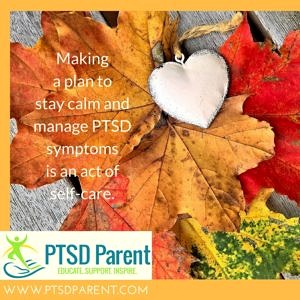 It can be difficult to simply remain calm during primetime Halloween trick-or-treating hours or during holiday parties, especially if your home is your safe space. Making a plan to stay calm and manage PTSD symptoms is an act of self-care. Here are some strategies I use to keep from losing my sh*t during Halloween.
It can be difficult to simply remain calm during primetime Halloween trick-or-treating hours or during holiday parties, especially if your home is your safe space. Making a plan to stay calm and manage PTSD symptoms is an act of self-care. Here are some strategies I use to keep from losing my sh*t during Halloween.
- Don’t Go – As I told my son, people with PTSD don’t go to haunted houses. I rarely go to Halloween parties. I
- Plan a Date – This date doesn’t have to be with another person; you can simply take yourself out for a special date. Go out to a restaurant for a couple of hours and then to the movies. Book a massage. Get your nails done, especially a pedicure. Head to the grocery store and run other errands.
- Make Your Own Noise – Hide in your room and put on noise-canceling headphones. Listen to the silence or play music. Watch a movie with the sound coming through your headphones. Turn on a really loud fan or a white noise machine to help drown out any other disturbances.
- Hang Out With a Friend – Preferably a friend who lives in the country where people don’t go trick or treating.
- Get Involved in a Project – Using your hands and brain can provide a distraction from anxiety. Choose a favorite type of project to do to keep your mind occupied, preferably one that requires a lot of concentration or has several steps to keep you focused.
Like most things, Halloween can be both joyous and difficult. However this time of year breaks down for you, hopefully you can make a plan for peace so that you can enjoy what you love about Halloween. Yes, including candy!
The post How to Be Calm: PTSD and Halloween appeared first on PTSD Parent.
]]>The post Not Good Enough for You? PTSD and Sexist Kids appeared first on PTSD Parent.
]]> What started with a PTSD trigger ended up with some serious reflection and questions about to what extent I have raised sexist kids.
What started with a PTSD trigger ended up with some serious reflection and questions about to what extent I have raised sexist kids.
I took advantage of this experience for my column over at Sweatpants & Coffee, appropriately called That’s What She Said. My youngest’s question, “So, you’re saying that your presentation was more important than my concert?” started a post traumatic stress disorder “you’re not good enough” event. The conversation ended with me questioning how they could possibly think that they could say something like that to me when they never have said anything like that to their father.
Enjoy this excerpt from the article, When You Realize Your Kids are Sexist, at Sweatpants & Coffee
“So, you’re saying that your presentation was more important than my concert?” asked my 12-year-old son at the dinner table one evening.
My breath stopped. Everything slowed down, from the beat of my heart to my son slurping a spaghetti noodle. My vision tightened down to a small tunnel and sounds blurred.
It was just your typical Post Traumatic Stress Disorder trigger, along with some good old-fashioned woman-rage.
The You’re Not Good Enough Trigger
 One of my big PTSD triggers is the belief that I’m not good enough. Anything I am and will be and try and do will simply never be good enough.
One of my big PTSD triggers is the belief that I’m not good enough. Anything I am and will be and try and do will simply never be good enough.
I understand where it comes from logically. Logic does not take the trigger away. Especially when your youngest child asks, “So your presentation was more important than my concert?”
I missed his concert due to a calendar conflict, like so many that have come before. Years ago, my husband and I decided that our boys have two parents, and we were going to take advantage of that. We work together, filling in for each other. He has missed recitals and games and concerts, as have I, but never both of us at the same time. We have also had many conversations with the children as these calendar conflicts have come up over the years.
And yes, I had another conversation about it that night, reminding our youngest of our past agreements and behavior and that his dad taped the concert so that we could watch it together the next day.
The next day, his words echoed around the inside of my skull – “So your presentation was more important than my concert?” Along with the leftovers of the trigger – the immediate anger, the hurt, the “you’re not good enough and you’ll never be.”
Go here to read the rest of When You Realize Your Kids are Sexist at Sweatpants & Coffee!
Searching for Hope and Inspiration? Check Out Caskets From Costco

A Funny and Poignant Grief Book
For twenty years, I thought that I had been marching through the stages of grief in a straight line. I had been following the formula, crossing each processed grief experience off my list.
Except that I was totally deluded. And I didn’t discover that until Jim, my beloved father-in-law, died. I found myself drying off from my shower the morning after his death, really hoping he couldn’t see me naked. Or, if he could, that he was averting his eyes.
From that moment, my path through grief resembled a roller coaster, spiraling and twisting and turning, circling back around. Echoes of past trauma, including childhood abuse and cheating death, would no longer be ignored. I somehow needed to get from the beginning to the end of this grief adventure, and I don’t have a good sense of direction.
But what is always present during a journey through grief, regardless of the path chosen?
Hope.
Caskets From Costco is a funny grief book that demonstrates the certainty of hope and healing in an uncertain and painful world.
Go Here to Read a Free Excerpt of Caskets From Costco!
The post Not Good Enough for You? PTSD and Sexist Kids appeared first on PTSD Parent.
]]>